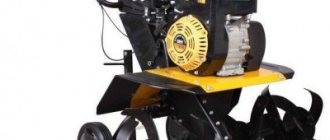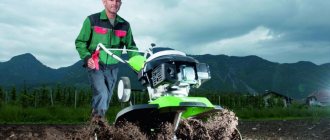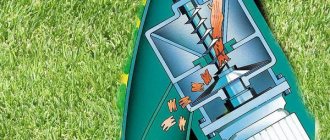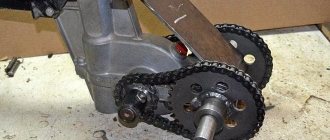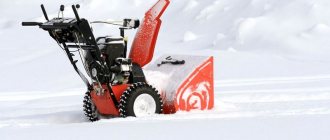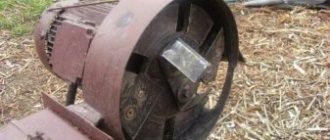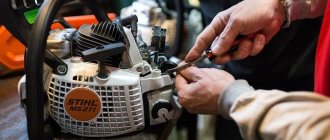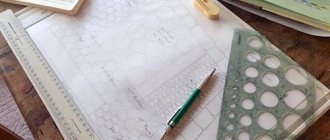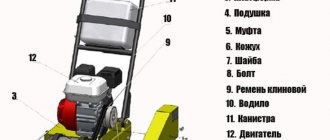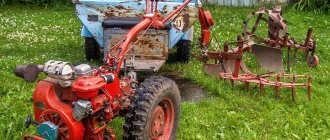why a manual cultivator today. To facilitate the cultivation of a plot of land, summer residents purchase various agricultural equipment - irrigation, sowing, harvesting, and soil care. The latter is the most labor-intensive and quite complex process, because it is necessary to harrow, loosen and dig up the soil. a hand cultivator for the garden can help you with this .
It will be useful in cultivating land on a small plot; it will help cultivate the land faster, more efficiently and with better quality.
There is a wide variety of cultivators available on agricultural machinery markets. Experienced gardeners and gardeners carefully select and purchase the much-needed tool.
To choose the right cultivator, you need to determine how often the equipment will be used and for what purposes. Let's compare the types of hand cultivators available on the market, their advantages and disadvantages.
What are the advantages of a manual cultivator?
Today, mechanical hand cultivators are poorly represented in advertising and on the Internet. The reason is their low cost. Much more emphasis is placed on motorized devices. However, the power and productivity of the latter is often excessive, especially for owners of small plots.
Getting by with a standard shovel is quite difficult and takes a long time: you need to have not just strength, but also excellent health, which is often lacking for pensioners, who are the most common owners of small summer cottages. The use of manual devices greatly simplifies the work, but at the same time does not hit the wallet as much as gasoline or diesel tools.
In addition, hand-held devices are very environmentally friendly. They use the simplest physical principles of force redistribution, such as a wheel, lever, gate, block, inclined plane and others. There is no noise, no exhaust gas emissions, and manual cultivators are much less prone to breakdowns. This is due to the minimum of components and simple connecting nodes.
The hand-held cultivator is always ready to work - it does not need an electrical outlet or fuel. Its storage conditions are an ordinary dry shed. For the minimum of problems and maintenance, it is loved by summer residents, gardeners and gardeners.
Use of a garden auger
- For drilling holes for planting large plants.
- For installing support posts.
- When constructing fences, wickets and gates.
The advantages of the new cultivator are ease of use, ease of assembly and excellent efficiency. The drill copes excellently with any soil structure, has the function of adjusting the length of the handle (according to the user’s height) and drilling depth. The Tornado super drill has appealed to amateur
gardeners Judging by the reviews, this model is almost 4 times superior to plate drills and 2.5 times better than auger drills. We are pleased with the affordable prices for this tool - within a thousand rubles and the warranty period of use is over 10 years.
Tornado garden forks are a convenient tool for carrying out work in the garden, carrying grass, hay, for cultivating heavy soils, and during planting. The fairly light weight (a little more than half a kilogram) and the presence of durable forged teeth contribute to the application of significant effort when performing work. For greater resistance to loads, the fork handle was made of metal. For high-quality soil cultivation, the tool was equipped with a foot pad function, which helps to carry out the labor process in an accessible and convenient way.
The advantages of the forks are a long service life, use in all weather conditions and an affordable price (about 800 rubles).
The Tornado snow shovel removes snow, sand, and grain without effort or strain on the lower back. The shovel weighs less than two kilograms. To make the cutting, we used a special pipe with a small diameter, durable and easy to use. The scoop is made of plastic that is not afraid of low temperatures and is quite durable. The shovel is designed to make the work of a gardener easier. It should be light and practical, comfortable and ergonomic (safe) - these are the qualities that the Tornado shovel is endowed with. A shovel in an aesthetically designed beautiful package can make an excellent inexpensive gift that will always help create a good mood and delight among gardeners.
All garden tools with the “Tornado” logo are very popular and in demand among summer residents and owners of private houses. Reviews from gardeners emphasize the ease and simplicity of use, low prices for the cultivator and its modifications. There are practically no negative comments. Pensioners with low incomes who feed themselves with the fruits of their hard work on their plots of land say special thanks to the manufacturers of this wonderful gardening equipment. And in this they receive invaluable assistance from the Tornado cultivator models, which are affordable for everyone.
Kinds
The design of manual soil cultivators is often quite simple. The purpose of this garden tool is to loosen the soil to aerate it and facilitate root growth, as well as better access to water when watering. The second function is the removal of ubiquitous weeds. And here a manual cultivator will give a hundred points ahead to a gasoline device.
It is simply impossible to squeeze through narrow row spacing with bulky attachments of a motorized unit. A compact hand-held device can cope with the task, and your hands will not experience vibrations that are dangerous to the musculoskeletal system.
The simplest manual ripper
This is a very simple and accessible tool. It consists of a rod mounted on a handle of varying length, from which extend three or more round-shaped curved “claws” with small triangular attachments at the ends, like a hook. Despite the primitive design, this ripper is quite effective. With its help, you can easily and simply pick up pieces of soil that have dried on the surface, and by dragging the tool along the ground with slight pressure, you achieve shallow furrows sufficient for regular occasional loosening.
Among the standard rippers there are both nameless models and those produced under brands such as Gardena.
Star cultivator
The popular name perfectly reflects the essence of this simple garden tool. In stores and reference books it is most often called rotary, since its action is based on a block of rotating sprockets made of durable hardened metal. The sprockets are mounted on an axis, sharpened and slightly turned out in order to simultaneously easily penetrate the soil and slightly turn it out.
Often a movable rectangular bracket is installed behind the sprocket block. When the gun moves forward, it becomes at a right angle to the frame, and when it moves back, it folds, taking part of the earth with it. If you sharpen such a frame, it cuts weeds well. In general, the tool is excellent for combined loosening and weeding.
Cultivator GRINDA 8-421888
Classic rotary cultivator with six stars. To improve loosening, the rays of the rotating mechanism are made transverse - this way they capture more soil, turning it outward. Three holders have screws for securing the star bits, of which there are two per holder. The kit includes a plastic rubber-coated handle of a short format, but you can use a screw to attach the cultivator to a long handle.
Manual cultivator Wolf Garten DA-S
This cultivator has four stars, the beams are flat, longitudinal, converging into a cone - this makes the work easier and ensures a gentle effect on the soil. Behind the sprocket block there is a bracket for removing weeds and distributing soil masses. The tool is made of stainless steel, which ensures long service life and absence of corrosion.
Flat cutter (Fokina ripper)
The simplest device that you can either buy at a garden store or make with your own hands. In appearance, it is very reminiscent of the hoe (hoe) common in the southern regions of Russia, that is, a blade curved at a right angle to the handle. A distinctive feature is a narrow blade, the width of which is comparable to the thickness of the handle and is 3 - 5 cm, as well as an oblique cut of the blade.
Thanks to its specific shape, a flat cutter is very convenient for doing small work, for example, removing weeds in the root zone of adult tomatoes, cabbage, peppers, and also weeding narrow rows in a greenhouse.
Manual cultivator "Tornadika" (root digger)
The production of these tools is branded and is associated among summer residents with the name of the company. The device is very simple: a horizontal handle made of a perpendicular tube is mounted on a vertical handle on one side, and several (usually three) teeth spirally twisted counterclockwise on the other.
They work with a cultivator by placing it on the soil and rotating the handle. Thanks to this, two problems are solved at once: the compacted soil is loosened, and if there is a weed in the area where the tines move, it will be thrown to the surface, even if it has a very powerful root system.
The Tornadika cultivator is popular due to the fact that it is very easy to work with: the back remains straight, and the fairly long handles allow you to rotate the device with little effort, using the effect of a lever.
Ripper "Mole"
Sometimes this device is called a “miracle shovel” for its properties of simultaneously digging and breaking clods of earth. It consists of two parts connected in two places and rotating on a longitudinal axis relative to each other. One part resembles straight, wide views, and the second resembles a lattice with vertical bars.
During use, the “forks” are driven into the ground with a foot, like the bayonet of a shovel, and the lattice part rests on the surface of the soil. When you press on the cutting, the rods rise, pulling out a lump of soil. When passing through the grate, the lump breaks, leaving an effect similar to using a regular shovel complete with a rake.
Mini plow
The most advanced, heaviest and expensive type of hand cultivator. In fact, it is a miniature plow for working alone or with two people. There is a wheel installed in front, most often a steel one with a flat rim, on the axis of which a frame with two handles is mounted. By hanging various equipment on the frame - plows, moldboards, furrowers, flat cutters - you can significantly increase the pace of work.
Manual mini-plows are produced by small enterprises in Russia and Ukraine (trade names “Slobozhanka”, “Batrak”, “Vinnitsa”). It can be recommended for intermediate farms, where the area of land cultivation is not yet so large as to require the purchase of motorized equipment, but at the same time, processing with standard individual means is difficult and problematic.
Famous manufacturers
In specialized stores you can see a large number of cultivators, which differ not only in price range, size and functions, but also in the country of production.
Experts recommend paying attention to products from domestic manufacturers, which have a number of advantages:
- ease of use;
- affordable price range;
- the presence of a large number of additional functions;
- production of components from high quality materials using modern equipment;
- possibility of replacing deformed parts;
- work performed only by high-level specialists.
The most popular domestic models are such devices as “Viking”, “Sadovnik”, “Neva”, “Mole”, “Tselina”, “Farmer”, “Strizh”, “Batrak”, “Roe”.
The Viking cultivator has a powerful gasoline-powered engine, and also has cutters and a hiller. This device has several models that have different configurations, functions and can be used to work with virgin soil and black soil. Experts recommend paying attention to the Viking’s ability to change the width of the land, as well as its maneuverability and versatility. A wide price range makes it possible for different categories of the population to purchase the device. The main advantage is reliability and long service life.
A budget option for cultivators for small beds, greenhouses and greenhouses is the “Gardener”, which will allow you to carry out work even in hard-to-reach areas. The designers provided for the installation of an engine on the apparatus. Steering and anti-vibration function make work much easier. The advantage is the location of the center of gravity at the bottom.
One of the most popular heavy-duty cultivators is the Neva. This device is only used for large areas. Disadvantage: low maneuverability, capture of a large area of soil. The advantage is the availability of spare parts and the ability to quickly install them. Twin wheels and steering wheel simplify the process of doing work.
The sales leader in the mid-price category of this group of products is the “Mole” cultivator, which has a simple design and high power. The availability of spare parts makes it possible to eliminate all faults in a short time.
For loosening and digging up light soil, you can purchase a “Virgin” device.
Among the main advantages, experts highlight the following:
- Ease of Management;
- using a minimum amount of physical effort;
- possibility of adjusting the control knob;
- presence of rear wheels;
- ease of transportation;
- the presence of metal brackets for transfer.
Disadvantages: inability to process dry and clay soil.
Experts recommend paying attention to the “Farmer” cultivator, which has three gears and reverse gear. The small size makes it possible to use the device near houses and trees. The cutting elements penetrate virgin soil to a depth of more than 20 cm. Manufacturers produce several models of this device with different price ranges.
Among European manufacturers, it is necessary to note the French and German and Gardena, whose products are distinguished by high power and reliability.
Most of the goods in modern stores are cultivators made in China. The main advantages of these products are the low price range and high level of aesthetic indicators. Before purchasing a Chinese cultivator, you need to know about its disadvantages:
- use of low quality raw materials;
- fragility of the starter in the engine;
- rapid deformation of the cover;
- regular replacement of components;
- rapid breakdown of worm gears.
Experienced gardeners recommend paying attention to the manual cultivator KR-1, which is a universal tool. The designers have provided the possibility of attaching a large number of attachments to a metal frame, and the height and dimensions of the device are harmoniously combined with the physical characteristics of all gardeners. Has reverse movement and self-cleaning functions.
The VKR-400 fork cultivator is an interesting development by domestic designers, which can completely replace a shovel and increase the speed of work. The tool has a horizontal steering wheel and a stop. The device makes it possible to loosen the soil without lifting a heavy layer of earth, which completely eliminates the load on the bone skeleton.
How to make it yourself
Considering that, compared to gasoline-powered equipment, hand cultivators are quite simple in design, many summer residents decide to make such a tool to facilitate field work with their own hands. Usually this is not so difficult, if you also make the most of various old things lying around idle in a barn or garage.
Of the specific tools that will be needed to make a homemade cultivator, the main one is a welding machine. Today, compact inverter devices are not so expensive and are quite widespread among the population.
What cultivator do you use?
PurchasedHomemade
Other tools can be found in almost every household:
- angle grinder (grinder) with cutting and sharpening disc;
- drill with a set of metal drills;
- a set of wrenches or socket heads with a wrench;
- pliers and hammer.
The material for a manual plow-cultivator can be a profile pipe - it is from this that the frame of the device will need to be welded. A wheel for moving on the ground can be taken from an old wheelbarrow or welded from reinforcement (spokes) and a steel strip rolled into a ring.
Features and Specifications
Technical characteristics of a manual root remover from the manufacturer Tornado:
- Russia, Bryansk;
- designed for soil treatment;
- product weight - 2 kg without packaging, 2.7 kg packaged;
- equipment: stand, handle, ripper attachment, fasteners;
- Factory warranty - 12 months.
The functions performed by hand cultivators can be divided into two large groups:
- Loosening the soil, which enriches the soil with oxygen, provides access to nutrients, moisture, and uniform distribution of fertilizers.
- Removing weeds that interfere with the growth and development of plants.
Operating procedure
- First of all, we weld the frame. It is easiest to make from two durable profile pipes of sufficient length. At one end, holes are drilled in the metal through which the axle on which the wheel will be held can be passed and secured with nuts.
- Immediately behind the wheel, across two pipes, a jumper is welded - a stiffener. At least three such ribs are usually made so that the structure acquires the necessary strength. At the other end of the pipes, a crossbar is welded to them, which serves as handles.
- A holder for attachments is made approximately at a distance of 30 - 40 cm from the wheel. It can be made from a corrugated pipe or two steel angles. The attachments are secured with bolts through the provided holes.
- The blade itself, if it is small, can be made from the blade of an old garden hacksaw, giving it the shape of a triangle with an obtuse angle at the apex. If we are talking about a heavier plowshare, then it is welded from a steel sheet 2 - 3 mm thick, and then the joint is sharpened.
- To prevent the working part of the cultivator from becoming dull, it is advisable to harden the product. To do this, it is heated until it glows bright red with a gas or propane burner, and then dipped in water or mineral oil.
Expert opinion
Levin Dmitry Konstantinovich
An old bicycle can be an excellent basis for a small hand cultivator. The minimum that can be used is a fork with a front wheel. Some craftsmen skillfully cut an old but strong bike so that the rear wheel rides on the ground, instead of a pedal block, a mini-plow or flat cutter is welded, and the summer resident clasps the unfolded and fixed steering wheel in his hands while walking behind the cultivator.
Motor cultivators
Motor cultivators have more power than electric ones, which means they are able to perform more difficult work over large areas. Power up to 3-5 hp allows you to cultivate the soil to great depth, and operation on fuel (gasoline) makes the device mobile, which is much more convenient when working on large areas.
